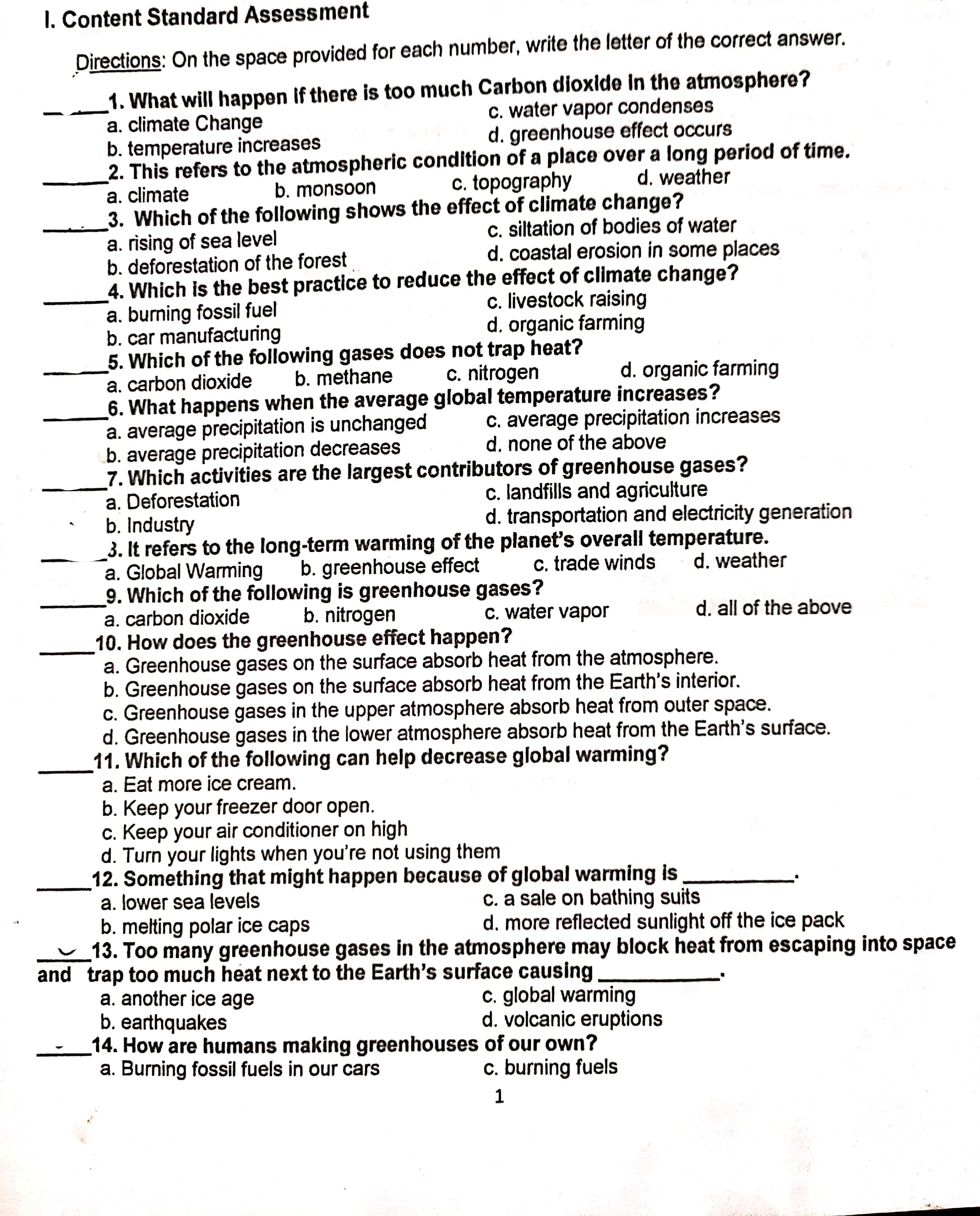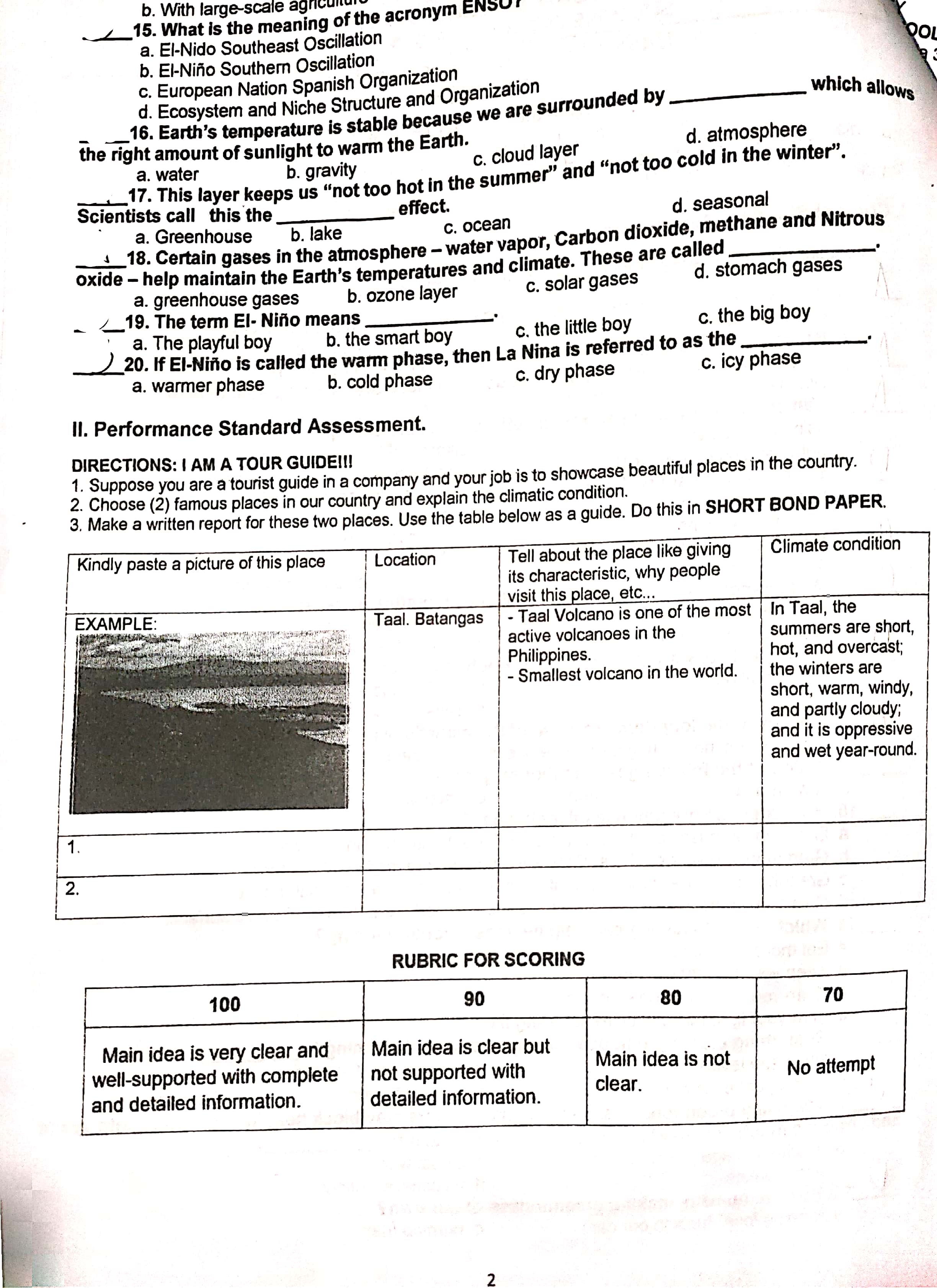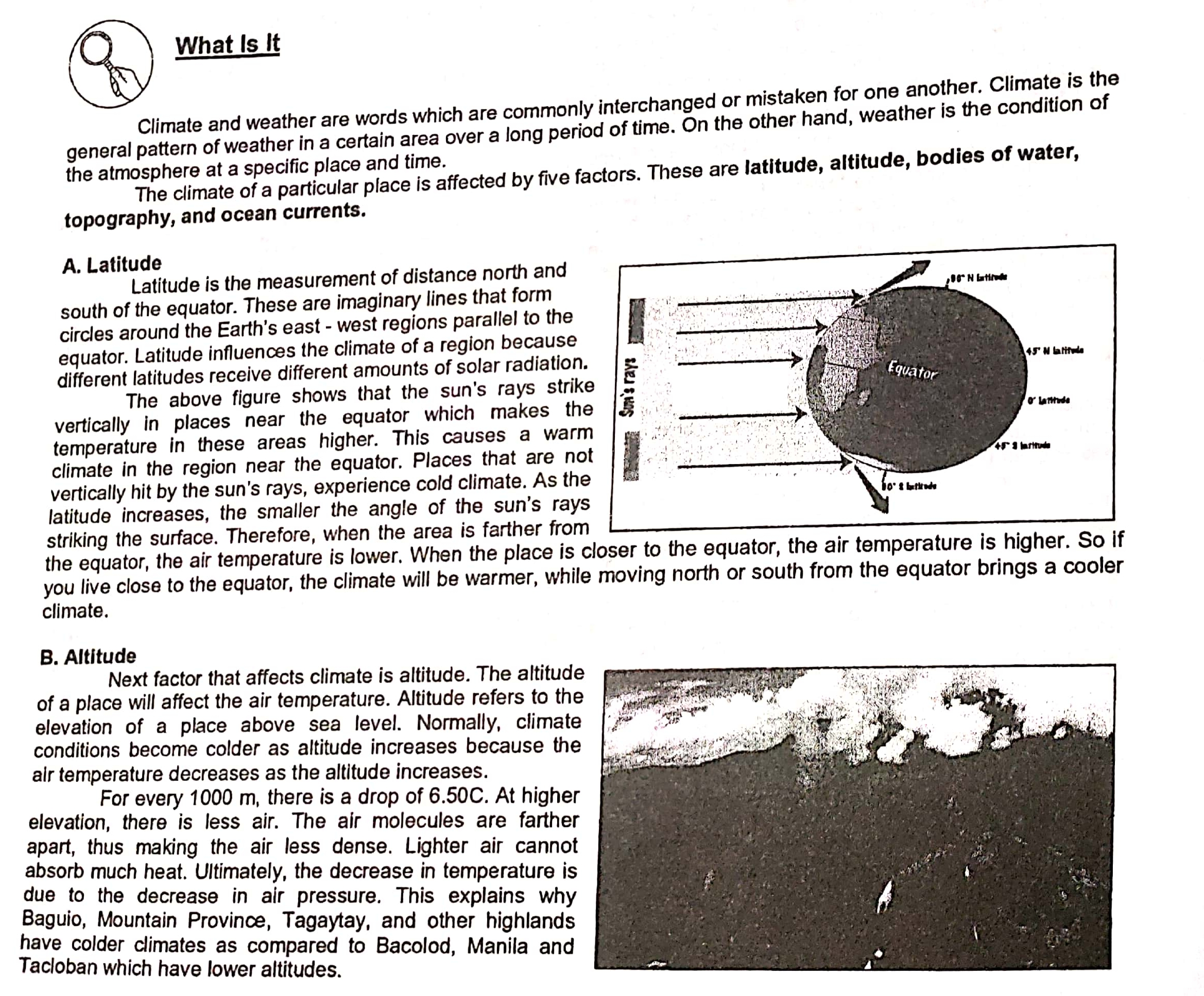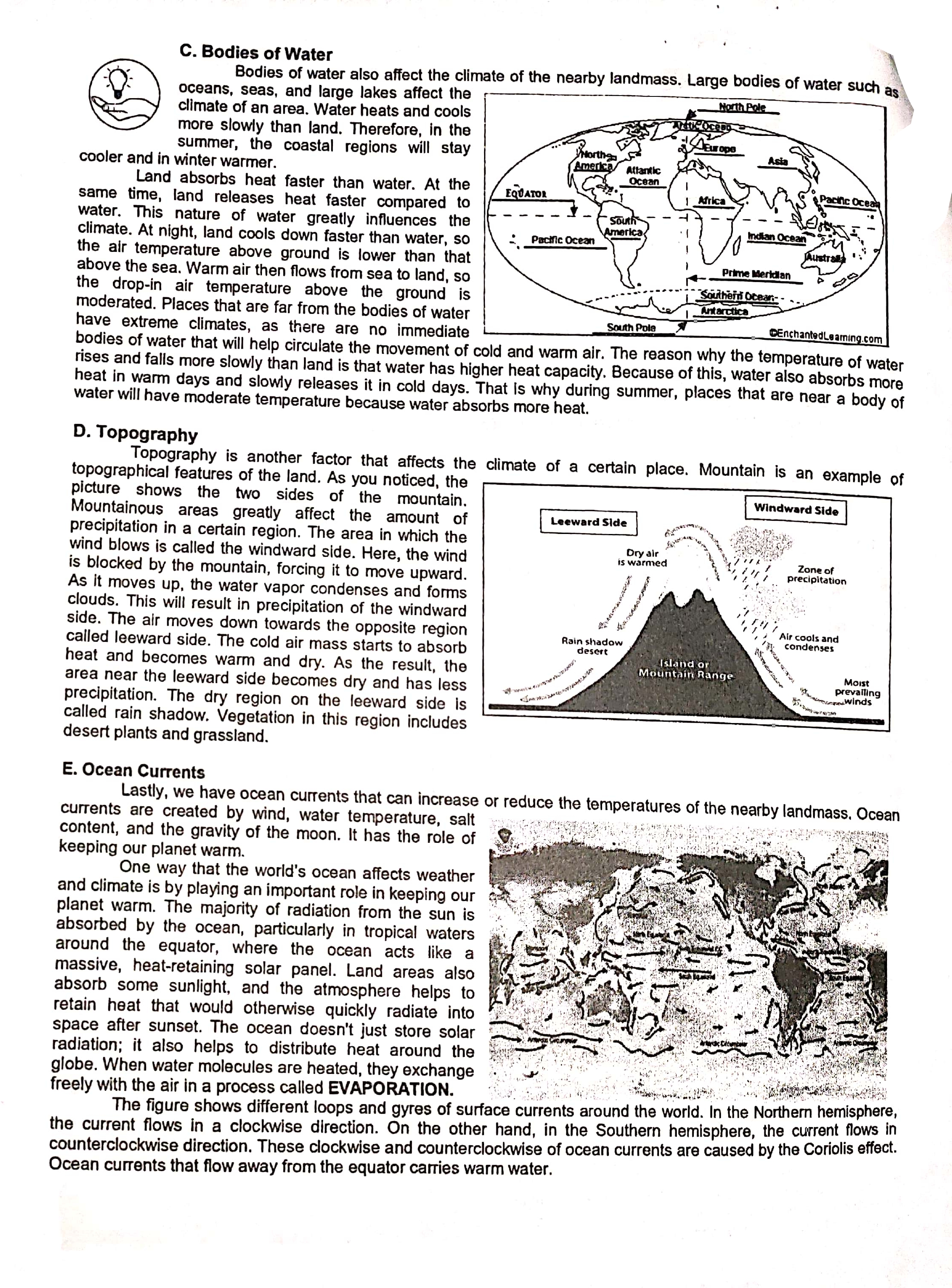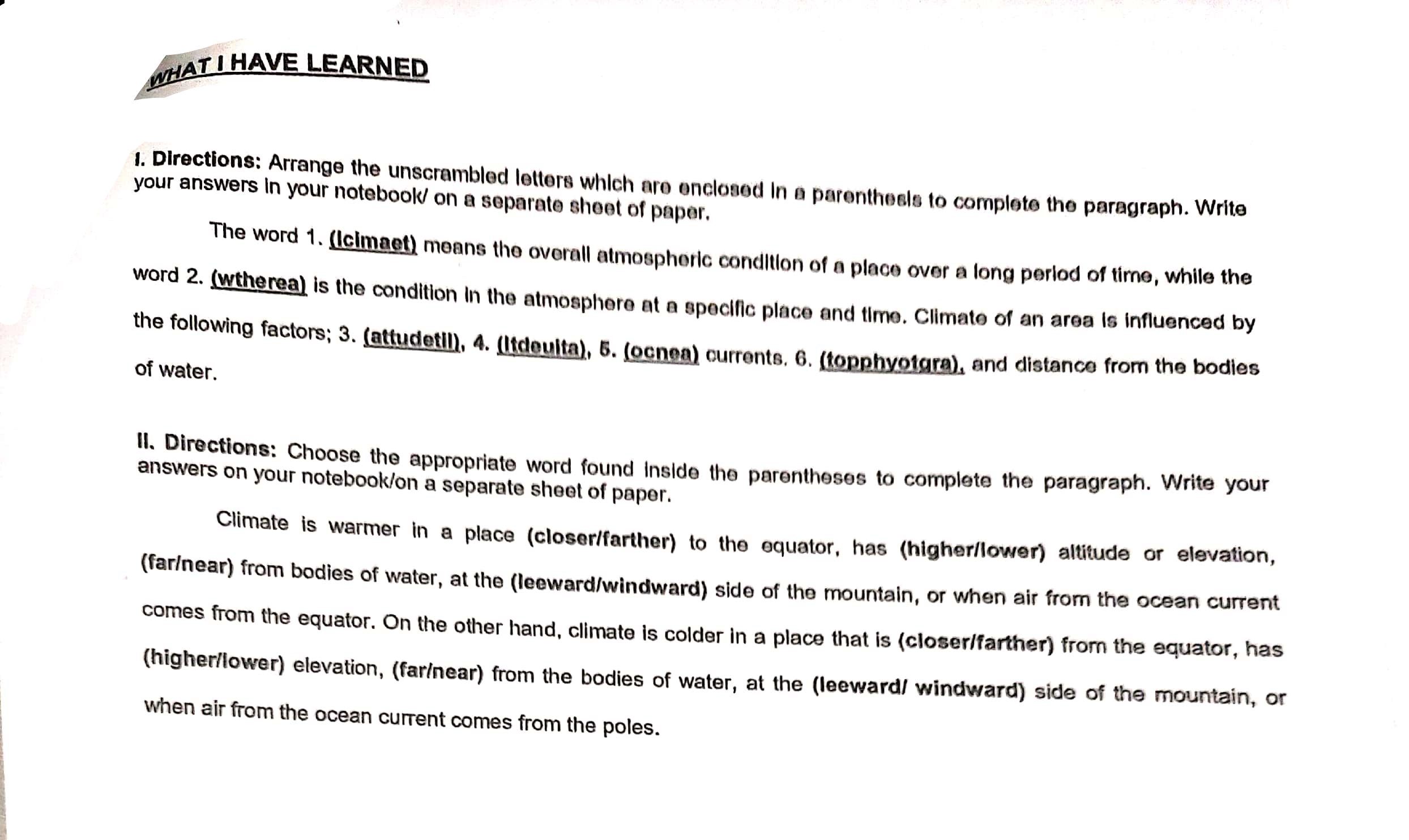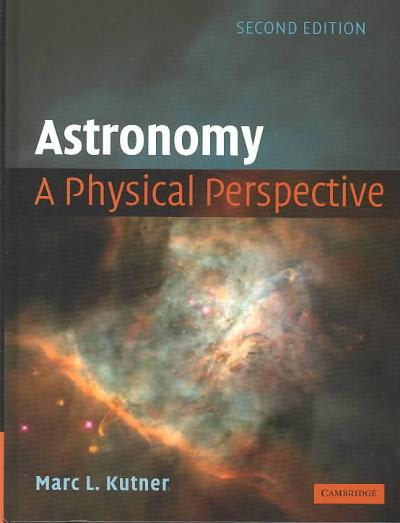Help me please, if you were to ask what will be your answer? Kindly answer this with detailed and clear explanation. Thank you.
I. Content Standard Assessment mber, write the letter of the correct answer. PM: On the space provided for each nu Carbon dioxide in the atmosphere? 1. What will happen if there Is too much _" c. water vapor condenses a. Climate Change d. greenhouse effect owurs b. tem erature increases 2. This;J refers to the atmospheric cendItlon of a place over a long period of time. a. climate b. monsoon c. topography d. weather 3. Which of the following shows the effect of climate change? a. rising of sea level c. siltation of bodies of water d. coastal erosion in some places b. deforestation of the forest ,. 4. Which is the best practice to re . . . a. burning fossil fuel c. livestock raising b. car manufacturing d. organic farming 5. Which of the following gases does not trap heat? a. carbon dioxide b. methane c. nitrogen d. organic farming 6. What happens when the average global temperature increases? a. average precipitation is unchanged c. average precipitation increases ,,b. average precipitation decreases d. none of the above 7. Which activities are the largest contributors of greenhouse gases? a. Deforestation c. landlls and agriculture d. transportation and electricity generation duce the effect of climate change? ' b. Industry _ 43. It refers to the long-term warming of the planet's overall temperature. a. Global Warming b. greenhouse effect c. trade winds d. weather 9. Which of the following is greenhouse gases? a. carbon dioxide b. nitrogen c. water vapor d. all of the above 10. How does the greenhouse effect happen? a. Greenhouse gases on the surface absorb heat from the atmosphere. b. Greenhouse gases on the surface absorb heat from the Earth's interior. c. Greenhouse gases in the upper atmosphere absorb heat from outer space. d. Greenhouse gases in the lower atmosphere absorb heat from the Earth's surface. 11. Which of the following can help decrease global warming? a. Eat more ice cream. b. Keep your freezer door open. c. Keep your air conditioner on high d. Turn your lights when you're not using them 12. Something that might happen because of global warming is a. lower sea levels c. a sale on bathing suits b. melting polar ice caps d. more reected sunlight off the ice pack v 13. Too many greenhouse gases in the atmosphere may block heat from escaping into space and trap too much heat next to the Earth's surface causing a. another ice age c. global warming b. earthquakes d. volcanic eruptions _-_14. How are humans making greenhouses of our own? a. Burning fossil fuels in our cars c. burning fuels 1 b. With large-scale agrio 15. What is the meaning of the acronym ENSO a. El-Nido Southeast Oscillation b. El-Nino Southern Oscillation c. European Nation Spanish Organization d. Ecosystem and Niche Structure and Organization which allows _16. Earth's temperature is stable because we are surrounded by the right amount of sunlight to warm the Earth. d. atmosphere a. water b. gravity c. cloud layer _17. This layer keeps us "not too hot in the summer" and "not too cold in the winter". Scientists call this the effect d. seasonal a. Greenhouse b. lake c. ocean _18. Certain gases in the atmosphere - water vapor, Carbon dioxide, methane and Nitrous oxide - help maintain the Earth's temperatures and climate. These are called d. stomach gases a. greenhouse gases b. ozone layer c. solar gases _19. The term El- Nino means c. the big boy a. The playful boy b. the smart boy c. the little boy 20. If El-Nino is called the warm phase, then La Nina is referred to as the a. warmer phase b. cold phase c. dry phase c. icy phase Il. Performance Standard Assessment. DIRECTIONS: I AM A TOUR GUIDE!!! 1. Suppose you are a tourist guide in a company and your job is to showcase beautiful places in the country. 2. Choose (2) famous places in our country and explain the climatic condition. 3. Make a written report for these two places. Use the table below as a guide. Do this in SHORT BOND PAPER. Kindly paste a picture of this place Location Tell about the place like giving Climate condition its characteristic, why people visit this place, etc... EXAMPLE: Taal. Batangas - Taal Volcano is one of the most | In Taal, the active volcanoes in the summers are short, Philippines. hot, and overcast; - Smallest volcano in the world. the winters are short, warm, windy, and partly cloudy; and it is oppressive and wet year-round. 1. 2. RUBRIC FOR SCORING 100 90 80 70 Main idea is very clear and Main idea is clear but well-supported with complete not supported with Main idea is not No attempt and detailed information. detailed information. clear.What Is It Climate and weather are words which are commonly interchanged or mistaken for one another. Climate is the general pattern of weather in a certain area over a long period of time. On the other hand, weather is the condition of the atmosphere at a specific place and time. The climate of a particular place is affected by five factors. These are latitude, altitude, bodies of water, topography, and ocean currents. A. Latitude Latitude is the measurement of distance north and south of the equator. These are imaginary lines that form circles around the Earth's east - west regions parallel to the equator. Latitude influences the climate of a region because different latitudes receive different amounts of solar radiation. The above figure shows that the sun's rays strike Equator Sun's rays vertically in places near the equator which makes the o' lanstude temperature in these areas higher. This causes a warm climate in the region near the equator. Places that are not 45 9 barttude vertically hit by the sun's rays, experience cold climate. As the latitude increases, the smaller the angle of the sun's rays striking the surface. Therefore, when the area is farther from the equator, the air temperature is lower. When the place is closer to the equator, the air temperature is higher. So if you live close to the equator, the climate will be warmer, while moving north or south from the equator brings a cooler climate. B. Altitude Next factor that affects climate is altitude. The altitude of a place will affect the air temperature. Altitude refers to the elevation of a place above sea level. Normally, climate conditions become colder as altitude increases because the air temperature decreases as the altitude increases. For every 1000 m, there is a drop of 6.50C. At higher elevation, there is less air. The air molecules are farther apart, thus making the air less dense. Lighter air cannot absorb much heat. Ultimately, the decrease in temperature is due to the decrease in air pressure. This explains why Baguio, Mountain Province, Tagaytay, and other highlands have colder climates as compared to Bacolod, Manila and Tacloban which have lower altitudes.C. Bodies of Water Bodies of water also affect the climate of the nearby landmass. Large bodies of water such as oceans, seas, and large lakes affect the North Pole_ climate of an area. Water heats and cools more slowly than land. Therefore, in the Europe summer, the coastal regions will stay cooler and in winter warmer. merica Attantic Land absorbs heat faster than water. At the Ocean EQUATOR Africa Pacific Oc same time, land releases heat faster compared to water. This nature of water greatly influences the south America climate. At night, land cools down faster than water, so Pacific Ocean the air temperature above ground is lower than that above the sea. Warm air then flows from sea to land, so Prime Meridian the drop-in air temperature above the ground is Southern Otear- - Antarctica moderated. Places that are far from the bodies of water have extreme climates, as there are no immediate South Pole DEnchantedLearning.com bodies of water that will help circulate the movement of cold and warm air. The reason why the temperature of water rises and falls more slowly than land is that water has higher heat capacity. Because of this, water also absorbs more heat in warm days and slowly releases it in cold days. That is why during summer, places that are near a body of water will have moderate temperature because water absorbs more heat D. Topography Topography is another factor that affects the climate of a certain place. Mountain is an example of topographical features of the land. As you noticed, the picture shows the two sides of the mountain. Windward Side Mountainous areas greatly affect the amount of Leeward Side precipitation in a certain region. The area in which the Dry air wind blows is called the windward side. Here, the wind is warmed Zone of is blocked by the mountain, forcing it to move upward. precipitation As it moves up, the water vapor condenses and forms clouds. This will result in precipitation of the windward side. The air moves down towards the opposite region Air cools and Rain shadow condenses called leeward side. The cold air mass starts to absorb desert heat and becomes warm and dry. As the result, the Island or Mountain Range MOIST area near the leeward side becomes dry and has less prevailing precipitation. The dry region on the leeward side is called rain shadow. Vegetation in this region includes desert plants and grassland. E. Ocean Currents Lastly, we have ocean currents that can increase or reduce the temperatures of the nearby landmass. Ocean currents are created by wind, water temperature, salt content, and the gravity of the moon. It has the role of keeping our planet warm One way that the world's ocean affects weather and climate is by playing an important role in keeping our planet warm. The majority of radiation from the sun is absorbed by the ocean, particularly in tropical waters around the equator, where the ocean acts like a massive, heat-retaining solar panel. Land areas also absorb some sunlight, and the atmosphere helps to retain heat that would otherwise quickly radiate into space after sunset. The ocean doesn't just store solar radiation; it also helps to distribute heat around the globe. When water molecules are heated, they exchange freely with the air in a process called EVAPORATION. The figure shows different loops and gyres of surface currents around the world. In the Northern hemisphere, the current flows in a clockwise direction. On the other hand, in the Southern hemisphere, the current flows in counterclockwise direction. These clockwise and counterclockwise of ocean currents are caused by the Coriolis effect. Ocean currents that flow away from the equator carries warm water.WHAT I HAVE LEARNED 1. Directions: Arrange the unscrambled letters which are enclosed in a parenthesis to complete the paragraph. Write your answers in your notebook/ on a separate sheet of paper. The word 1. (Icimaet) means the overall atmospheric condition of a place over a long period of time, while the word 2. (wtherea) is the condition in the atmosphere at a specific place and time. Climate of an area is influenced by the following factors; 3. (attudetil), 4. (Itdevita), 5. (ocnea) currents. 6. (topphyotgra), and distance from the bodies of water. Il. Directions: Choose the appropriate word found inside the parentheses to complete the paragraph. Write your answers on your notebook/on a separate sheet of paper. Climate is warmer in a place (closer/farther) to the equator, has (higher/lower) altitude or elevation, (farear) from bodies of water, at the (leeward/windward) side of the mountain, or when air from the ocean current comes from the equator. On the other hand, climate is colder in a place that is (closer/farther) from the equator, has (higher/lower) elevation, (farear) from the bodies of water, at the (leeward/ windward) side of the mountain, or when air from the ocean current comes from the poles
